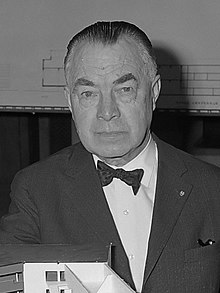Bernard Bijvoet
Bernard Bijvoet (born December 14, 1889 in Amsterdam , Kingdom of the Netherlands ; † December 27, 1979 in Haarlem , Netherlands) was a Dutch architect who became known for applying the principles of New Building and New Objectivity .
Life
Bijvoet's father was the Amsterdam paint manufacturer William Frederik Bijvoet, his younger brother was the chemist Johannes Martin Bijvoet . He attended the public high school (HBS) and began his studies in 1908 at the Technical University of Delft, where he met Jan Duiker . Both finished their studies in 1913 and worked for a few years in Professor Henri Evers' office , although they had different views on his designs for the construction of the city hall (stadhuis) in Rotterdam .
In 1916, Bijvoet and Duiker opened their own architecture office in Zandvoort . You won a competition to design a retirement home in Alkmaar , De Karenhuizen . In addition, they designed the Villadorp Kikjduin (1922–1923), a house in Aalsmeer and a drugstore in Zandvoort. Her designs for the Tribune Tower in Chicago , Illinois , USA and the headquarters of the League of Nations in Geneva were not carried out.
In 1925, Bijvoet stopped working with Duiker and went to Paris . There he joined the office of the French architect Pierre Chareau . With Chareau, he designed the Maison de verre in Paris , the Dalsace house in the 7th arrondissement , at 31 rue Saint-Guilleaume. This building and other structures erected in France made him very well known there, while his name was not very well known at home.
After Duiker's death in 1935, Bijvoet completed his design for the Grand Hotel Gooiland in Hilversum , but remained in France. There he worked with architects such as Eugène Beaudouin (1898–1983) and Marcel Lods (1891–1978). During the Second World War he moved to the countryside in the Dordogne . After the war he went back to the Netherlands and founded an office in Haarlem with the architect Gerard Holt . Among other things, he designed a house in Aerdenhout and, together with Holt, apartment blocks in Katwijk aan Zee, Hoek van Holland , Rotterdam, Haarlem and Velsen .
In the 1950s, Bijvoet designed apartments in various areas of Amsterdam, for example in the Amsterdam development area Guizenfeld together with Jacob Bakema and others. He also specialized in theater acoustics . It was created together with his partner Holt Theater in Tilburg and Nijmegen , and in the 1960s in Apeldoorn and Tiel . In Amsterdam, in the Ferdinand Bolstraat , an opera house with an attached hotel tower was to be built in place of an old concert hall. The opera house was not built, the hotel tower of the Okura hotel chain was completed in 1968–1972 by the architects Bijvoet, Holt, Yoshirō Taniguchi and Yōzō Shibata .
Bijvoet was married twice. The first marriage resulted in a daughter and a son.
drafts
- 1926–1931: Zonnestraal Sanatorium (Naazorg Colony), Hilversum with Johannes Duiker and Jan Gerko Wiebenga
- 1926–1927: with Pierre Chareau: Clubhouse of the Beauvallon Golf Club
- 1928–1930: with Pierre Chareau: Maison de verre , Paris, 7th arrondissement .
- 1948–1950: with Gerard Holt : Villa Looyen, in the dune area of Aerdenhout in Bloemendaal , province of North Holland . Listed as a Rijksmonument since 2011 .
- 1955–1961: with Gerard Holt: Stadsschouwburg Nijmegen
- 1968–1972: Okura Hotel, Amsterdam.
- 1969: Theater (Agnietenhof), St. Agnietenstraat, Tiel .
honors and awards
- Officer of the Ordre van Oranje-Nassau
literature
- Fernando Montes: Pierre Chareau with Bernard Bijvoet: Maison Dalsace ("Maison de verre") . ADA Edita, Tokyo 1977 (English).
Web links
- CV of architects (English)
| personal data | |
|---|---|
| SURNAME | Bijvoet, Bernard |
| BRIEF DESCRIPTION | Dutch architect |
| DATE OF BIRTH | December 14, 1889 |
| PLACE OF BIRTH | Amsterdam , Kingdom of the Netherlands |
| DATE OF DEATH | December 27, 1979 |
| Place of death | Haarlem , the Netherlands |



